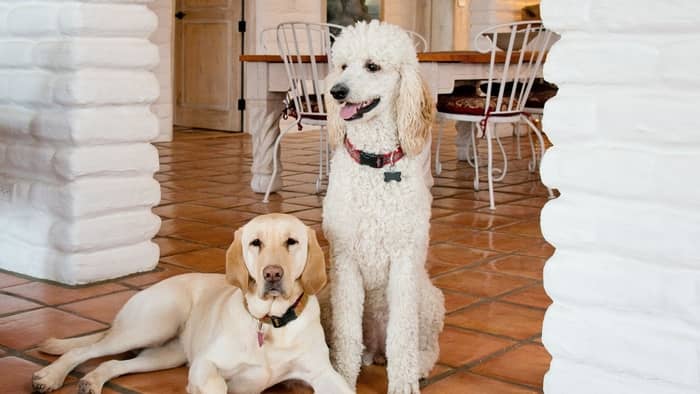Last Updated on September 22, 2023 by Linda Richard
Labradoodles are rapidly rising in popularity these days but the different types of doodles tend to confuse people. So, what is an F1 Labradoodle, and is this the right dog for you? What about F1b doodles? And F2? F2b? These designations can be confusing at first but, we promise, they really aren’t all that complicated.
Table of Contents
What Is An F1 Labradoodle?
Very simply put, an F1 doodle is a 1st generation Labradoodle. So, it’s a cross between a purebred poodle and a purebred Labrador Retriever. This technically makes the F1 Labradoodle a 50/50 cross but you should keep in mind that dogs rarely take exactly 50% of each parent’s characteristics.

Learn more about: How Much Are Labradoodles Worth In Pet Stores and Breeders?
So, even though an F1 Labradoodle is a 50/50 dog, it may look more like one of its parents or more like the other. This is very important to note regards to two particular characteristics:
- Coat type and shedding
- Physicality
The first point is one of the main reasons why many people are drawn to the Labradoodle crossbreed. What most folks think they are getting with this dog is a hypoallergenic and non-shedding Labrador Retriever – essentially a lab with a poodle’s coat. And while this is certainly a possibility, you should remember that most F1 Labradoodles are not exactly that – some indeed have poodle-like coats but others’ coats are almost identical to that of a lab. So, if you absolutely need a hypoallergenic dog, it’s probably best to just get a poodle or an F1b Labradoodle (more on them below).
As for the physicality of these dogs, this is often overlooked but is quite noteworthy. Even though poodles are also an energetic sporting breed, Labrador Retrievers are indubitably the stronger and more physical breed. So, an F1 Labradoodle can really go either way in this regard as well. Plus, it also matters what the exact lab parents are, there are different lab sub-breeds. The difference between an American and English lab is quite significant, for example.
F1 vs F1b Labradoodle
Now that we know what is an F1 Labradoodle, let’s check out the other most popular designation you’ll encounter – F1b. These are crossbreed dogs of a second generation. However, they are specifically a second generation born out of the cross of an F1 Labradoodle and either a purebred lab or a purebred poodle.
More often than not when we’re talking about F1b Labradoodles, we’re talking about an F1 doodle crossed with a poodle rather than a lab. The reason is quite simple – people really want hypoallergenic lab-like dogs. So, by making an F1b Labradoodle with a second poodle thrown in the mix, they are increasing the chances of a poodle-like coat as these dogs are 75% poodle and only 25% lab.
In fact, there are even F1bb dogs. As you’ve probably guessed, those are the offspring of an F1b Labradoodle crossed with another purebred poodle. That effectively makes the F1bb an 87.5% poodle and 12.5% lab. Such a dog is almost guaranteed to have a low-shedding and hear-hypoallergenic coat. However, it will also share most other poodle characteristics. Essentially, at this point, you might as well just get a purebred poodle.
What Do These Letters and Numbers Stand For?
We’ve thrown quite a few figures and letters around so let’s explain each of them before we go any further:
- The capital letter F stands for the word “filial” – a word describing the relationship between a parent and its offspring
- The number after F describes the number of generations since the last purebred parent – not the overall generation number since the first crossing of purebred parents. That’s why F1b and F1bb dogs still have the number 1 in them – cause they keep getting crossed with other purebred dogs.
- The small letter b at the end stands for “back cross”, meaning that the crossbreed has been back-crossed with a purebred dog.
F1 vs F2 Labradoodle
So, we got what is an F1 Labradoodle and what backcrosses are. What about F2 Labradoodles? As you might have guessed, these are second-generation Labradoodles – the offspring of two F1 doodles. As there are no new purebred dogs added to the mix, an F2 dog is technically still a “50/50 mix”. However, because it’s further separated from its purebred ancestors, it’s an even more unpredictable cross – it can either be almost completely lab-like or very much poodle-like. Or, it can be anywhere in between.
To make matters even more convoluted, there are also F2b, F2bb, F3 crosses, and so on. The big three to keep in mind, however, are F1, F1b, and F2.
In Conclusion, What Is An F1 Labradoodle?
An F1 Labradoodle is the classic Labradoodle mix most people imagine when they hear the name – the offspring of a poodle and a lab. Depending on the reason you want such a dog, however, you may also want to consider an F1b cross with a little extra poodle or a little extra lab in it. It’s also worthwhile to check what the exact poodle and lab parents are – after all, those can vary quite a bit too.
Read more about: Australian Labradoodle vs American Labradoodle – Which Is The Right Doodle For You?
FAQs
What is an F2 Labradoodle?
Simply put, an F2 Labradoodle is a second-generation crossbreed. That’s a dog with two F1 Labradoodle parents and four purebred grandparents – two labs and two poodles.
So, technically, an F2 Labradoodle would be 50% Labrador Retriever and 50% poodle, just like an F1 Labradoodle. However, because it’s a second-generation dog, that’s not really how it works. The exact genetic makeup of an F2 dog would be entirely unpredictable because there’s no telling exactly which genes each of its F1 Labradoodle parents took from their own grandparents. This doesn’t make F2 dogs “bad”, of course. They’ll still be somewhere between a poodle and a lab, so they’ll be great dogs either way. It’s just unpredictable which purebred dog your F2 doodle will be more alike.
How much do F1 b Labradoodle puppies cost?
F1b Labradoodles are very sought-after nowadays which naturally bumps up their price. These dogs tend to cost an average of $1,500 to $2,000 from reputable breeders. Such dogs should always come with detailed heath certificates both for the pup and its parents. Depending on the exact characteristics of the parents (whether they are quality stock sporting dogs, for example), an F1b Labradoodle can even cost as much as $4,000.
Granted, you can find lower prices at pet stores – usually down to $1,000. However, pet store puppies tend to be bred in puppy mills which are really ill-advised places for getting puppies from. Puppy mills are notorious for breeding their dogs indiscriminately and with no regard for the health of the puppies. And that’s not to mention the horrendous conditions puppy mills usually keep their dogs in – another reason not to support them. You’ll even often see shelters and rescues charging around $500+ for a rescue F1b Labradoodle puppy.

